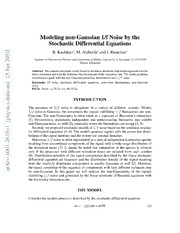Table Of ContentModeling non-Gaussian 1/f Noise by the
Stochastic Differential Equations
0 B. Kaulakys , M. Alaburda and J. Ruseckas
∗ ∗ ∗
1
0
InstituteofTheoreticalPhysicsandAstronomyofVilniusUniversity,A.Gostauto12,LT-01108
2 ∗
Vilnius,Lithuania
n
a
J Abstract. Weconsiderstochasticmodelbasedonthelinearstochasticdifferentialequationwiththe
5 linearrelaxationandwiththediffusion-likefluctuationsoftherelaxationrate.Themodelgenerates
1 monofractalsignalswiththenon-Gaussianpower-lawdistributionsand1/fb noise.
] Keywords: 1/f noise, stochastic differential equations, power-law distributions, non-Gaussian
n noise
a
PACS: 05.40..a,72.70.+m,89.75.Da
-
a
t
a
d INTRODUCTION
.
s
c
The presence of 1/f noise is ubiquitous in a variety of different systems. Mostly
i
s
1/f noise is Gaussian, but sometimes the signals exhibiting 1/f fluctuations are non-
y
h Gaussian. The non-Gaussianity is often taken as a signature of fluctuator’s interaction
p
[1]. Nevertheless, statistically independent and noninteracting fluctuators may exhibit
[
non-Gaussiannoise,as well [2], especiallywhen thefluctuationsare strong[3, 4].
1
Recentlyweproposedstochasticmodelsof1/f noisebasedonthenonlinearstochas-
v
5 tic differential equations [5, 6]. The models generate signals with the power-law distri-
3 butionsofthesignalintensityand thepower-lawspectral densities.
6
Moreover,1/f noiseisoften represented as asumofindependent Lorentzianspectra
2
. resulting from uncorrelated components of the signal with a wide-range distribution of
1
the relaxation times [7]. It should be noted that summation of the spectra is allowed
0
0 only if the processes with different relaxation times are isolated from each another
1
[8]. Distribution densities of the signal components described by the linear stochastic
:
v differential equation are Gaussian and the distribution density of the signal resulting
i
X from the similarly distributed components is usually Gaussian as well [3]. However,
r the signal consisting of the sequence of components with very different variances may
a
be non-Gaussian. In this paper we will analyze the non-Gaussianity of the signals
exhibiting 1/f noise and generated by the linear stochastic differential equations with
thefluctuatingrelaxation rate.
THE MODEL
Considertherandomprocess xdescribed bythestochasticdifferentialequation
dx= g (t)xdt+s dW (1)
−
withthetimedependentrelaxationrateg (t).HereW istheWienerprocess,dW =x (t)dt,
with x (t) being the d -correlated white noise, x (t)x (t ) = d (t t ), and s is the
′ ′
h i −
intensity(standard deviation)ofthe whitenoise.In this paperthe stochasticdifferential
equationsweunderstandin Itointerpretation.
When the relaxation rate changes very slowly, we have the signal as a sequence of
signalswithdifferent relaxationrates.
We can eliminate the parameter s by the appropriate change of the time scale,
t s 2t, while the change of the relaxation rate g (t) may be described by another
st→ochasticdifferentialequation,resulting,e.g., inthepower-lawdistributionofg .
Therefore, wehavethesystemoftwo equations,
dg =s g g m dWg , (2)
dx= g xdt+dW. (3)
−
Here s g determines the speed of the change of the relaxation rate g driven by the
white noise x g and the factor g m imposes the power-law distribution, Pr(g ) g h (with
h = 2m ), of the relaxation rate. The diffusion-likemotion of g should be r∼estricted in
−
someinterval,e.g., (0,1). Then
P(g )=(1+h )g h . (4)
r
We can restrict the analysis of the positive x, only, with the reflection of x at x = 0.
Forthedefiniteg thedistributionofxisGaussianandthepowerspectrumisLorentzian,
g
P (g x)=2 e gx2, (5)
1 | rp −
S (g f) (g 2+w 2) 1. (6)
1 −
| ∼
Forveryslowevolutionoftherelaxationrateg ,theresultingcharacteristicsofthesystem
(2)and(3)yieldsfrom theaverageofexpressions(5)and (6)overdistribution(4),
2(1+h ) 3 3
P(x)= P (g x)P(g )dg = G +h G +h ,x2 , (7)
Z 1 | r √p x3+2h (cid:20) (cid:18)2 (cid:19)− (cid:18)2 (cid:19)(cid:21)
S(f)= P (g f)P(g )dg 1/f1 h , f 1. (8)
1 r −
Z | ∼ ≪
HereG (a,x)is theincompletegammafunction.
Therefore, the simple linear stochastic equation (3) with the additive noise, linear
relaxation and the power-law distribution near zero of slowly changing relaxation rate
resultsasymptoticallyin thepower-lawdistributionofthesignal,
P(x) 1/x3+2h , x 1, (9)
∼ ≫
andpower-lawdistribution(8)ofthelowfrequency spectrum.
Fortheuniformdistributionoftherelaxationrateg ,i.e.,form =h =0,wehavefrom
Eqs.(7)and (8)
1 1
P(x)= erfx exp( x2), (10)
x3 −x2 −
S(f) arctan(1/2p f)/f. (11)
∼
100 104
(a) (b)
10-1 103
10-2
102
P(x)1100--43 S(f) 101
100
10-5
10-6 10-1
10-7 10-2
10-2 10-1 100 101 102 10-5 10-4 10-3 10-2 10-1 100
x f
FIGURE1. Probabilitydensity (a) and powerspectrum (b)of the signalgeneratedaccordingto Eqs.
(2)and(3)withm =0ands g =2 10−4incomparisonwiththeanalyticalexpressions(10)and(11).
·
100 103
(a) (b)
10-1
102
10-2
x)10-3 f) 101
P(10-4 S( 100
10-5
10-1
10-6
10-7 10-2
10-2 10-1 100 101 102 10-3 10-2 10-1 100
x f
FIGURE2. Asin Fig.1,butwith m =0.1,opencircles,and m = 0.1,opensquares,incomparison
−
withEqs.(8)and(9).ThelowestsolidcurverepresentsGaussiandistribution.
NUMERICAL ANALYSIS
We have performed numerical analysis of the model (2) and (3), as well. In figure 1
the simulation results for m = 0, i.e., for the case of pure 1/f noise are presented. We
see good agreement with the analytical expressions in large intervals of frequency and
distributionofthesignal.Figure2showsthedependencesofdistributionandtheslopeof
thespectraldensityontheparameterm . Inallcasesthedistributiondensityofthesignal
exhibits the “fat tail” distributions in contrast to the short-range Gaussian distribution
forthefixed relaxationrateg .
Weanalysedthemultifractalityofthesignals,aswell.Forthispurposewecalculated
ageneralized qthorderheight-heightcorrelation function(GHCF) F (t)defined as[9]
q
F (t)= I(t +t) I(t ) q 1/q, (12)
q ′ ′
h| − | i
where the angular brackets denote the time average. The GHCF F (t) characterizes
q
the correlation properties of the signal I(t), and for a multiaffine signal a power-law
101 0.01
)
(tq 100 Hq 0.005
F
10-1 0
10-1 100 101 102 103 104 105 0 0.5 1 1.5 2
t 1/q
FIGURE3. Generalizedheight-heightcorrelationfunctionF (t)versustimet,(a),andthegeneralized
q
HurstexponentsHqversus1/q,(b),ofthemodel(2)and(3)withm =0ands g =2 10−4.
·
behavior,
F (t) tHq, (13)
q
∼
isexpected.HereH isthegeneralizedqthorderHurstexponent.IfH isindependenton
q q
q, a singlescaling exponentH is involved,and thesignal I(t)is said to be monofractal
q
[9,10]. IfH dependson q, thesignalis consideredtobemultifractal.
q
Calculation results shown in Fig. 3 indicate that the signal is monofractal with the
HurstexponentH 0 and theslopeofthespectrumb =2H+1, as forrandomwalk.
≈
CONCLUSION
The linear stochastic differential equation with the slowly fluctuating relaxation may
b
generatemonofractalsignalswiththenon-Gaussian1/f noise.
ACKNOWLEDGMENTS
We acknowledge the support by the Agency for International Science and Technology
DevelopmentPrograms inLithuaniaand EU COST ActionP10 “PhysicsofRisk”.
REFERENCES
1. C.E.Parman,N.E.Israeloff,andJ.Kakalios,Phys.Rev.Lett.69,1097(1992).
2. G.T.Seidler,S.A.Solin,andA.C.Marley,Phys.Rev.Lett.76,3049(1996).
3. B.Kaulakys,V.Gontis,andM.Alaburda,Phys.Rev.E71,051105(2005).
4. V.Orlyanchik,V.I.Kozub,andZ.Ovadyahu,Phys.Rev.B74,235206(2006).
5. B.KaulakysandJ.Ruseckas,Phys.Rev.E70,020101(R)(2004).
6. B.Kaulakys,J.Ruseckas,V.Gontis,andM.Alaburda,PhysicaA365,217(2006).
7. J.Bernamont,Ann.Phys.(Leipzig)7,71(1937).
8. F.N.Hooge,PhysicaB239,223(1997).
9. E.Bacry,J.Delour,andJ.F.Muzy,Phys.Rev.E64,026103(2001).
10. J.W.Lee,K.E.Lee,andP.A.Rikvold,PhysicaA364,355(2006).

